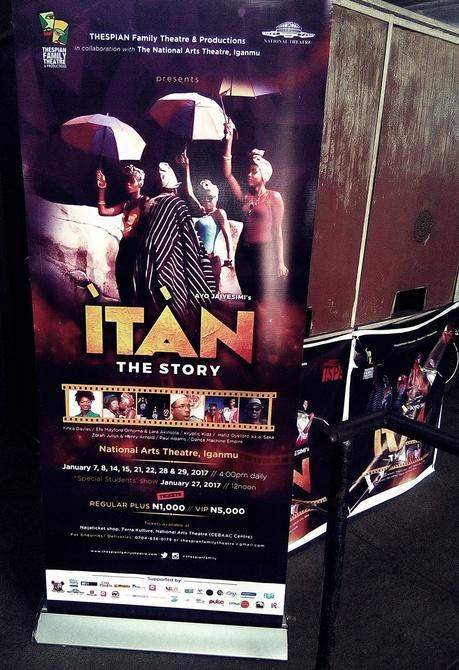 Recently, I was opportune to see one of Ayo Jaiyesimi’s stage plays, ÌTÀN, performed beautifully at the National Arts Theatre in mainland, Lagos.Director Ben Tomoloju put together an amazing show that was focused on depicting the cross-generational conflicts prevalent in modern day Africa. The story centred on cross-generational back and forth scenes between traditional and contemporary time periods cohesively moderated by Asiko; the personification of Time.
Recently, I was opportune to see one of Ayo Jaiyesimi’s stage plays, ÌTÀN, performed beautifully at the National Arts Theatre in mainland, Lagos.Director Ben Tomoloju put together an amazing show that was focused on depicting the cross-generational conflicts prevalent in modern day Africa. The story centred on cross-generational back and forth scenes between traditional and contemporary time periods cohesively moderated by Asiko; the personification of Time.
An intriguing dance which portrayed the battle between modernity and traditionalism served as the prologue to the play. An abrupt pause in dance moves introduces the narrator’s voice as he relays Asiko’s task to bridge the cross-generational divide. At the play’s start, Pa Lantiwo laments the snatching away of his only daughter by the city. Amidst his lamentations he is paid a visit by a young man who brings him news about his grandson in the city. This brings joy to Papa and inspires his search for his only grandson, Dee-kay. The expressions and acts that portray Papa’s cultural shock on his arrival to the city are light-heartedly amusing. Feeble looking Papa stands his ground in the midst of the new generation hippies. He receives the shock of meeting his ‘city roller-coaster’ grandson, Dekola, a new generation musical celebrity who maintains that he and Papa were worlds apart. Culture clash is evident. Asiko’s entrance begins the phase that shows time intertwines the past and the future. We come to see the relationship between the events in Pa Lantiwo’s life and Dee-kay’s ; and how cultural differences transcend time. As Asiko takes Papa and Dee-kay on the journey from the past to the future we are introduced to Pa Lantiwo’s youth where he out wins Baku for the hand of Asake, the village beauty, who chooses love over fortune. This enrages Baku and sows the seed of vindictiveness. Unfortunately, for Pa Lantiwo, beautiful Asake dies while birthing Laraba. The story of Pa Lantiwo’s past brings on impatience to Dee-kay’s new generation mind. Viewing his impatient expressions bring a knowing smile to my lips as I momentarily recall my own impatience when I listened to my parents retell their pasts for the umpteenth time. The death of Asake throws young Pa Lantiwo into a prolonged depression which leads to alcoholism and neglect of parental responsibility, consequently this leads maladjusted Laraba to fall prey to vindictive Baku’s lures to a better life in the city. In the end, as we advanced to witness Dee-kay’s future we see that Dee-kay became Baku’s illegitimate child and that his disregard for his history; his past would inevitably lead to the success of Baku’s sinister and vindictive plans to wed Dee-kay’s true love as he is already presently posed as his creative manager popularly known as The Godfather. The scene changes were smooth as we transitioned from cultural traditional scenes to contemporary ones. There was no dissonance with the music which flowed fluidly from tribal songs to popular nostalgic 90’s music and on to contemporary secular songs. I appreciate that even though the story of the play was rooted in Yoruba, meaningful representations of other ethnic tribes were made. The costumes were unique to each group of characters and time eras, and everything complements each other. Each actor is worth noting and even the physically smallest, a four or five year old girl, was amazing.

